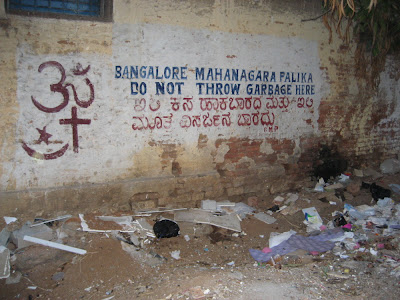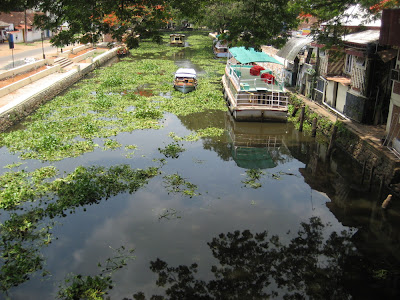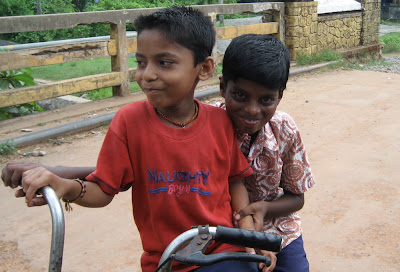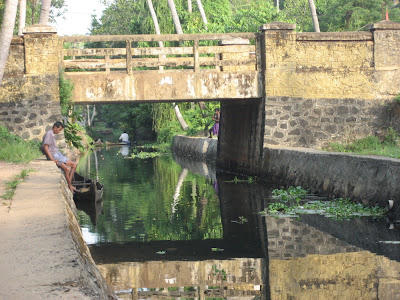by Dori
Our flight on Emirates from Bangalore to Damascus
stopped in Dubai, so we decided to spend one day
checking out a city that we had heard was the “Las
Vegas” of the Middle East.
Dubai is a fascinating place: First of all it is an
emirate, with its own ruler, Mohammed bin Rashid Al
Maktoum. Five emirates joined to form the United Arab
Emirates in 1971, which is located north of Saudi
Arabia and west of Oman.
We arrived late on a Wednesday night but even in the
dark, the wealth and modernity of Dubai is visible
everywhere. Everything is new including the airport,
and a taxi whisked us to our hip Ibis hotel that’s
connected to the new convention center.
We had read that one of the few historical areas of
Dubai was the Souq (or bazaar) down by the Dubai creek
where Dubai was founded. Everything from spices to
computers is sold in the district around the bazaar.
But by 9am it was sunny and hot in Dubai, so the souq
wasn’t too busy – mostly people went straight from
their cars into air-conditioned shops.
From the souq we walked to the Dubai museum which
turned out to be very cool: Most of the museum was
made up of rooms filled with mannequins, artifacts and
soundtracks that attempted to recreate life in Dubai
for the hundreds of years previous to the last 50
during which all of Dubai’s development has taken
place. It’s truly amazing – the people of Dubai went
from living in tents along the creek to a city full of
skyscrapers and a global population in one lifetime.
And there’s no end to the growth – from the museum we
took a cab across the city and there are at least 50
enormous skyscrapers under construction. Most of them
will house the global immigrants that move to Dubai
every year in search of tax-free salaries.
From afar we were able to see the Burj Al-Arab hotel –
one of the most famous hotels in the world. It cost
$1.5 to build and the cheapest room is $1,000 per
night. It was built right into the ocean, and the
lower floors are aquariums where you can see the ocean
life outside the hotel walls. This is only one of many
amazing things about this hotel – you can learn more
about it at:
http://en.wikipedia.org/wiki/Burj_al-arab
Our next stop was the Mall of the Emirates. No
ordinary mall, this mall includes an indoor ski area –
there’s only one run, but it’s about 3 stories high,
and the snow is real! We didn’t blow a ton of money
trying it out, but people looked like they were having
fun. We were amazed to see that this mall was filled
with people from all over the world, including lots of
Westerners that obviously lived in Dubai.
Not only is Dubai extremely wealthy like the other
emirates, but it is also ruled by a very progressive
sultan with policies that promote economic and
population growth. While the local population of Arabs
native to Dubai make up only about 5-10% of the
population, the majority of the city’s population is
Arabs from other parts of the Middle East, westerners,
and the largest immigrant group, Indians.
One of my friends from Thunderbird, Manish Punjabi, is
one of these Indian immigrants whose family has been
living in Dubai for many years now. Manish works for a
telecom company in downtown and shares an apartment
nearby with his friend Kevek, who joined us for dinner
that night.
Once the sun goes down, Dubai becomes the perfect
temperature, so we met up with Manish and Kevek, took
a stroll along the creek, and ended up at a Persian
restaurant where we all sat on a large rug, ate
wonderful food and smoked a hookah pipe (called
Sheesha in Persian).
It was great to get an insiders view of both Dubai,
and India where we’d just come from, from Manish and
Kevek. They joked that, “Dubai is India’s greatest
city,” due to the fact that a majority of Indian
immigrants have helped make Dubai what it is today.
However they did say that there was some
discrimination towards Indians – they are not welcome
at posh clubs where locals hang out (they are told
they’re “not on the list”).
We ended our only, but very full day, in Dubai at a
jazz club inside one of Dubai’s hotels with drinks and
live jazz. Alcohol is ONLY served inside hotels, as
the majority of the local conservative Muslim
population does not drink. The next morning we left
for Syria.
We had a great time in Dubai, but there was something
slightly artificial about the all the brand new,
ostentatious skyscrapers in the middle of the desert…a
lot like Las Vegas.
SYRIA 11th May – 21st May
We catch an early flight out of Dubai to Damascus. My father was born in Homs, Syria and I have many relatives living there whom I haven’t seen since I visited in 1980. I am looking forward to seeing everyone again and introducing them to Dori. Both of us however, have some trepidation traveling here as Americans given the catastrophe brought on by our current administration. It must be said that our guidebook states right from the beginning that Syria is one of the safest countries to travel in period, and there has never been one documented case of violence against a Westerner.
On our approach, we can see Damascus airport, it consists of two runways without any activity on them. Curious then, our plane circles the airport 4 times before landing. The flight crew offers no explanation for the extra flying, leaving many of us to curiously gaze out the window, until we finally descend and land on the next pass.
We make our way to passport control and after several minutes trying to explain our occupations to the amused man behind the glass (“computer” for film editing and “dentist” for dental products marketing) our passports are stamped and we are in Syria.
“Go back as far as you will into the vague past, there was always a Damascus…She has looked upon the dry bones of a thousand empires and will see the tombs of a thousand more before she dies.” Mark Twain, The Innocents Abroad, 1869
Damascus is the oldest continuously inhabited city in the world. Excavations in the Umayyad mosque have been dated back to the 3rd millennium B.C. Conquerors over time have included King David of Israel, the Assyrians, the Persians, Alexander the Great, the Romans, the Ottomans and from 1920 – 1945, it was a French mandate. In 1945 Damascus became the capital of an Independent Syria.
We arranged a car from our hotel to pick us up at the airport which lies about 15 miles outside Damascus. As we near the city the sky takes on a strange sepia color. We later learn this is caused by a sandstorm moving in from the eastern desert and probably the cause of our delayed landing. We later ask if this is normal (the storms) and are told it’s a pretty rare occurrence, once or twice a year. We arrive on a Friday, which is the weekend in Syria. Everything is closed and the streets of Damascus are almost completely empty of traffic and pedestrians. This combined with the curious sky and the ubiquitous banners of Bashar Assad give the city a ghostly feel.
We visit the Umayyad mosque. Worship on this site dates back 3000 years and the mosque itself is a beautiful and tranquil structure. We visit the “Special Dressing Room” and Dori dons a long grey robe, we remove are shoes and walk around the open courtyard before going inside the prayer hall where the “Shrine of John the Baptist,” a marble and green glass structure, sits in the center of the hall. According to old stories, a casket was found under the basilica floor in the 8th century and was said to contain the Saint’s head.
Afterwards we spend the rest of the day wandering through the old city and it’s winding streets. Merchants stand in front of their shops enticing us to come look “for the pleasure of our eye” at what they’re offering. We take a look at a couple shops regardless whether or not you buy anything browsing always turns into coffee, tea and chitchat with the shop-owner.
We have dinner in a restored Ottoman house in the old city and puff on nargileh (hookah) in between our mesas (appetizers) and Arak. Arak is a by product of the wine-making process, a brandy made from the bits left over, like Italian grappa but with the addition of aniseed. Needless to say it’s pretty strong stuff, the quality is usually determined by how you feel the next day.
The next day Damascus comes alive and the streets and souks are filled with people going about their day. In the afternoon we get a pleasant surprise, the Middle Eastern rep from the company Dori worked at has put us in touch with some friends in Damascus.
We go to a beautifully restored Ottoman house that is now a boutique hotel with a restaurant and an art gallery. Called ‘Art House,’ its current exhibition is works by Syrian expatriates. The architect who has remodeled the premises gives us a quick tour and a description of each of the works.
After dinner Farzat and Fayza take us for a drive around Damascus. It’s a completely different city at night, the urban sprawl becomes a sea of lights. We drive to the nearby mountain ‘Jebel Qassioun.’ People are parked all along the way; families, couples, friends, all having snacks and taking in the view.
The next day we take a taxi 2 hours north the city of Homs. This is where my father was born and where most of my relatives are living. Homs is the 3rd largest city in Syria after Damascus and Aleppo and is definitely more of an industrial city with textile manufacturing making up the majority of business here.
We arrive at the apartment building where most of my relatives still live and it’s pretty surreal and quite emotional to see all these faces again after almost 30 years. Almost all my relatives are still in Syria except for 4 cousins living elsewhere 3 of whom I was able to speak with via my aunt Sana’s mobil since they are her daughters. We spend the week talking about life in the USA, life in Syria, family origins, politics, careers etc, all over wonderful homemade meals. The embarrassing chubby photos from 1980 make an appearance (not included here!) so we make sure to take many new (bit less chubby) pix to replace the incriminating evidence.
My cousins take us on different tours in and around Homs. On day we visit the Krak Des Chevaliers, one of the most well preserved Crusader castles in the world.
Another day we visit the creaking, wooden waterwheels of Hama called norias. Built as early as 5th century AD, these wheels used the river currents to scoop up water and deposit onto an aqueduct where the water would flow for irrigation purposes. Sitting in a café, there is something hypnotic about these wheels and many Arabian poets have written of the “sad wheels of Hama.”
We plan on going out to the desert to see the ruins of Palmyra but flash flooding has closed the roads.
After one week in Homs it’s time to move on so we exchange all the pertinent emails, addresses and numbers and bid our farewells. My cousin Moukles drives Dori and I to Aleppo where we will spend on day before catching a bus into Turkey. It’s a two-hour drive and as we head north I’m amazed at the fertileness of the land on Syria’s western side. Acres upon acres of crops fill the horizon as do the mountains of Jebel Ansariyya.
When we pull into Aleppo it definitely has a much more metropolitan, busy commerce feel than anywhere else we’ve been in Syria. Dominating the skyline is the Citadel, which the Muslims used as a base during the Crusades. The three of us walk around the Citadel and then walk through Aleppo’s vast souk on the hunt for the fabled Aleppo hand soap made from laurel and olive oil.
We spend one night in the city, have a great meal on a rooftop terrace restaurant near our hotel. Speaking of which, our hotel in Aleppo deserves mention. It’s called the Baron Hotel and was once the preeminent place to stay in the Middle East. Time has not been kind but it was interesting to see in the lobby a bar bill from TE Lawrence (Lawrence of Arabia) and notes from Agatha Christie who wrote part of ‘Murder on the Orient Express’ while staying here.
The next day we catch an early bus out of the Aleppo to the Syrian/Turkey border and cross over without incident. As the Syrian border recedes behinds us, Dori and I both know we’ve been somewhere truly special where friends and family took us in and gave us a glimpse into this country few Americans will ever see.


















